A knitted dress pattern is an ideal solution for sewing a unique outfit. The fabric is easy to care for and dresses made from it practically do not wrinkle. Such a knitted dress can be worn for any occasion - the owner will always look great.
- Tools for sewing knitwear
- Secrets
- Selection of material
- Material consumption
- Features and techniques of sewing knitwear
- How to find out the degree of stretch of knitwear
- Pattern of a dress with a stand-up collar
- Dress pattern with draped waist
- Pattern of a sports dress made of knitwear with a hood.
- Step-by-step algorithm
- How to cut a knitted dress with sleeves using a pattern
- Side seam of the back and shelf
- Shoulder line of the shelf
- Processing the bottom of the sleeve
- How to sew a dress without a pattern
Tools for sewing knitwear
You don't need any special equipment to work with knitwear. It's important to have the following on hand:
A sewing machine. It should come with:
- Needles with a rounded head. There are several varieties: "jersey" or "stretch". The first variety is sewing knitwear with an admixture of wool and cotton. The second is synthetic fiber with a high percentage of lycra.
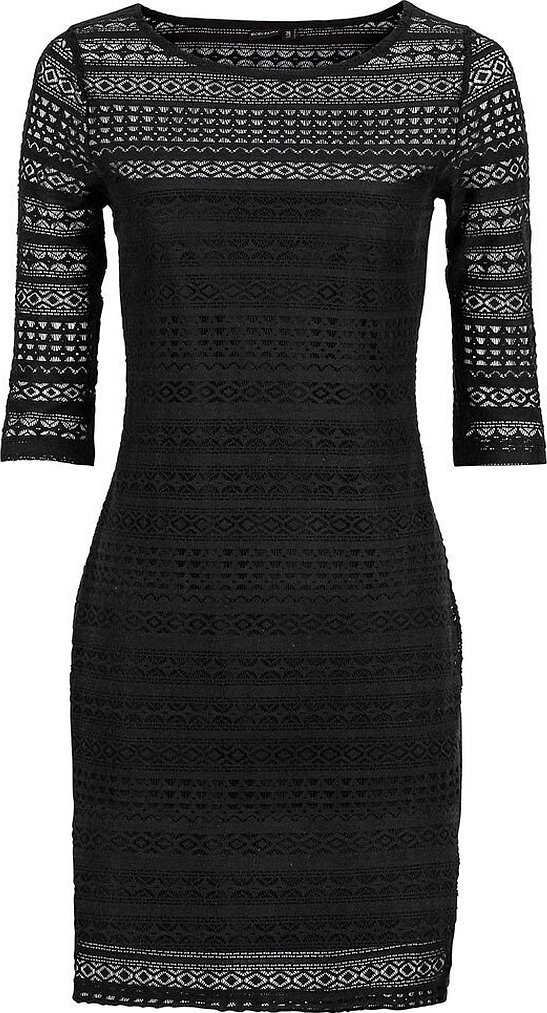
Regarding the size of the needle required, no one can give a comprehensive answer. One thing is clear: the thinner the fabric, the smaller the needle should be for sewing a product from the fabric.
Please note! Before you start sewing, it would be a good idea to stitch a line on the rags and check the quality of the sewing.
- Double needle — removable mechanism. Feature — makes several stitches at once. Applicable for facing the bottom of the product, armholes. On the front side there will be parallel stitches, on the back — zigzag.
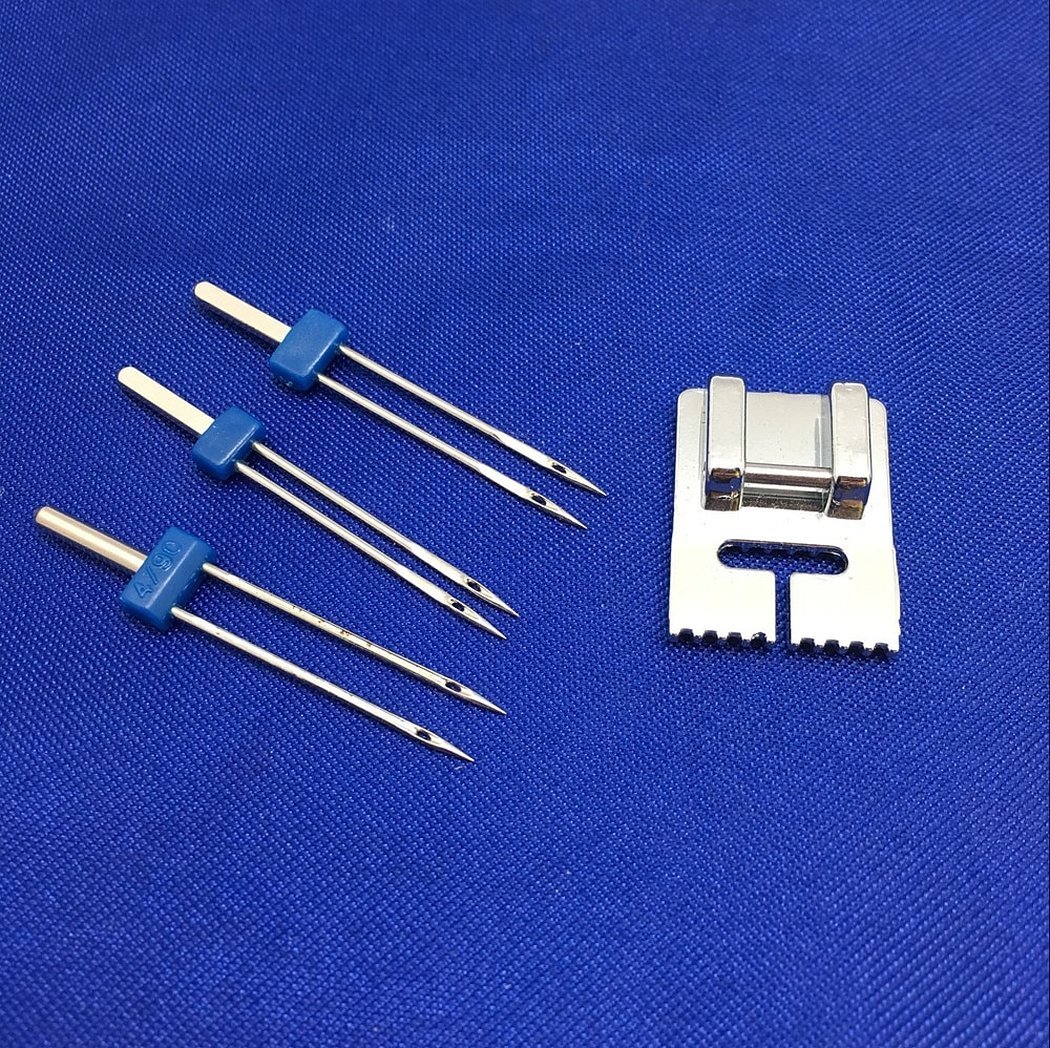
Important! The twin needle is suitable for any type of sewing machine.
Threading of a double needle is carried out from two spools simultaneously. Spools are installed on both pins of the machine so that they are unwound in different directions. This eliminates the possibility of thread tangling. If the machine has one pin, then the second spool is placed in the box and the thread is wound.
Secrets
If the lower thread does not catch, perform the following actions:
- Loosen the needle mounting screw;
- Lower the needles a little lower, but not too much;
- Tighten the fastening screw;
- They check whether the defect has been eliminated.
Upper conveyor - sews together several layers of stretch fabric. This mechanism allows the upper layer of fabric to scroll, while the lower conveyor feeds the lower panel. The main task of the conveyors is to ensure the synchronous movement of two panels of material.
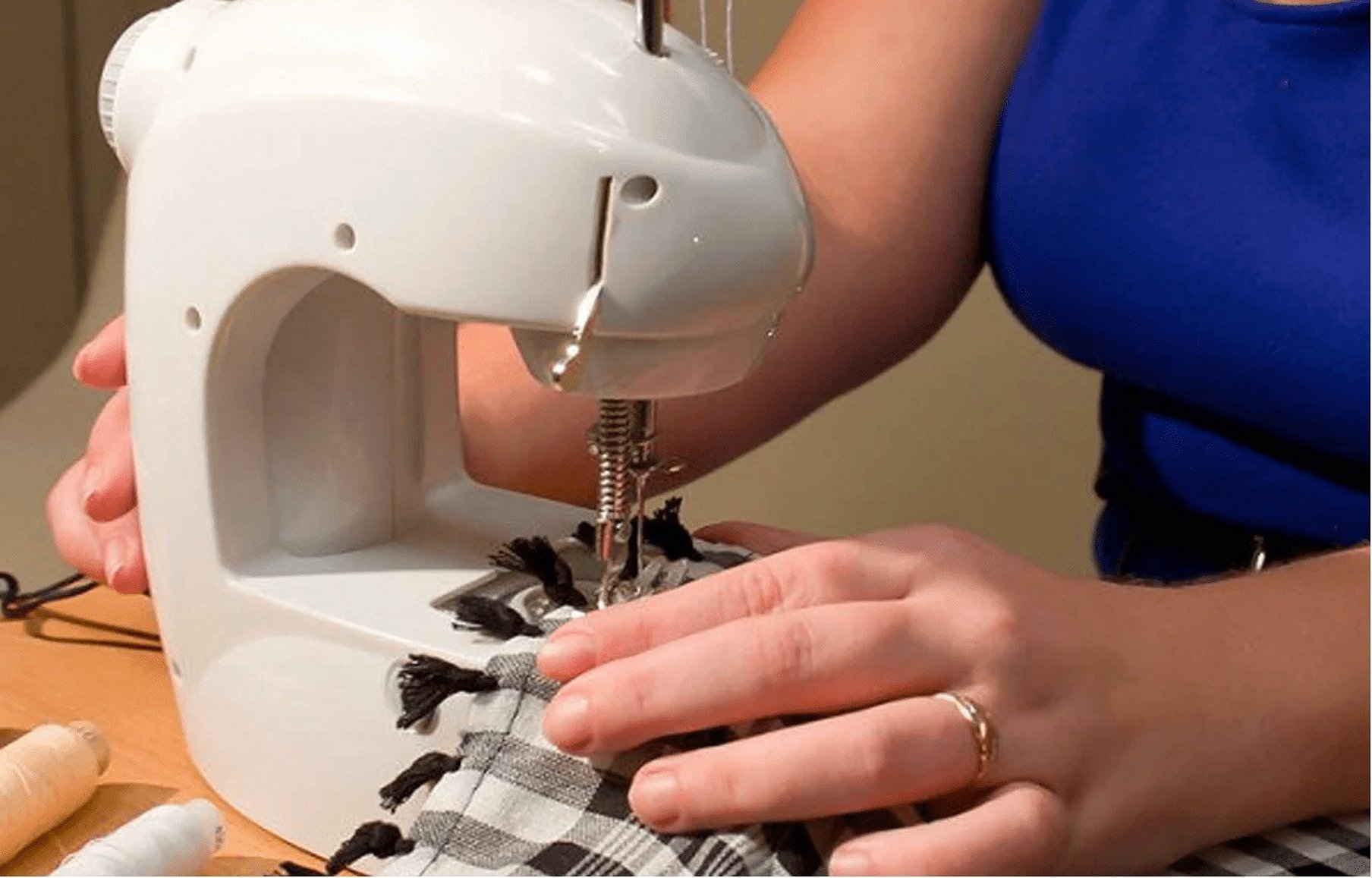
The mechanism will not be needed if there is a professionally developed habit of manually basting 2 pieces of fabric together. This mechanism is necessary for industrial sewing of products, its use significantly saves workers' time.
The walking foot pushes the top layer of fabric. For beginner seamstresses, it is better to baste 2 pieces of fabric by hand to begin with.
Please note! Threads are selected smooth, elastic with long fiber: polyester, nylon. Most novice seamstresses do not go into such details as the composition of the thread - they choose from those available. The main rule is to match the color scheme of the product.
Selection of material
When choosing fabric for a dress, you need to adhere to the following criteria:
- Decide on the style. If the cut of the clothes is complex, the material should be thin. If there is drapery, preference should be given to the corresponding type of knitwear;
- Take your build into account when choosing fabric for your dress;
- Surface of the material: glossy or matte. Gloss is suitable for women with ideal figure proportions. A plump woman needs to carefully consider the choice of fabric and style.
- Seasonality of the product. Summer and winter knitwear will differ in their properties and thickness parameters.
Please note! The choice of a particular type of knitted fabric depends on the style of the dress, body type and wishes.
If the knitwear contains synthetics and stretches, it is not necessary to carry out preparatory work. It is laid out knitted dress pattern and the product is cut out.
Cotton jersey ("underwear") shrinks after several washes. This must be taken into account when cutting the material. It is necessary to wash the material several times and dry it. The material will shrink and after that you can iron the product and cut it out. From this fabric you can make a children's suit for a girl, a home set, a long sarafan. Such a product can be sewn by a novice seamstress.
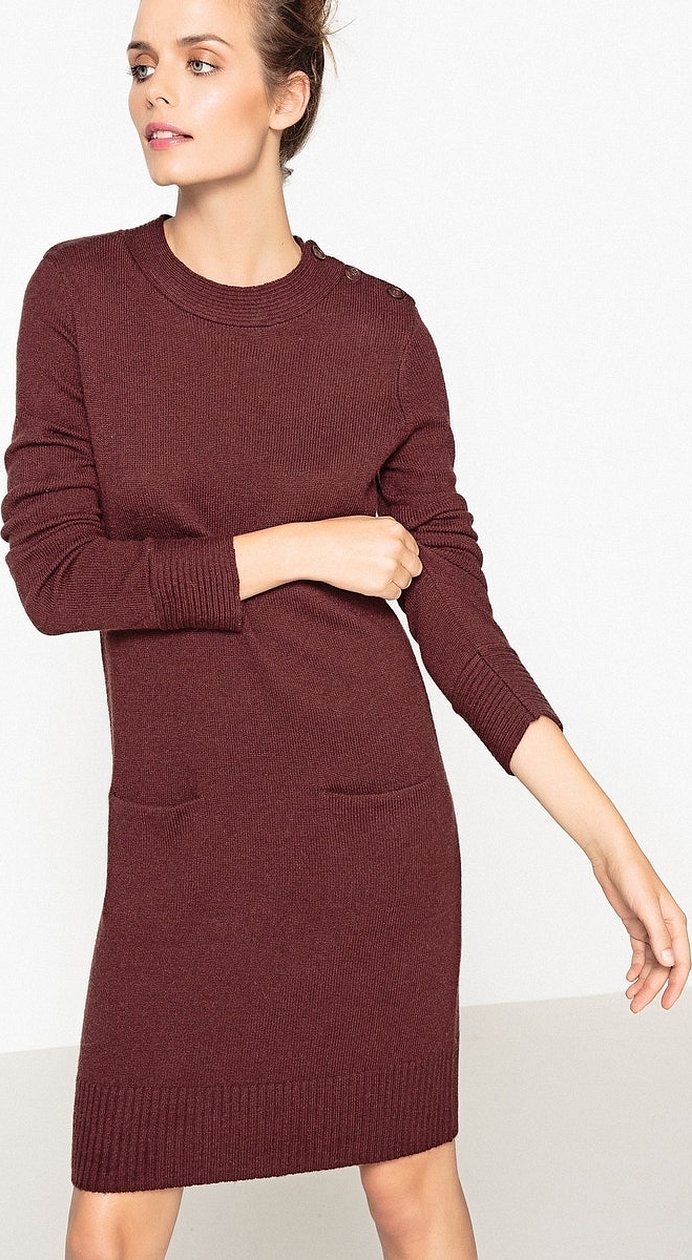
Ironing rule:
- The material is ironed from the inside out, using an ironing board. The knitwear shines when ironed and does not emit a smell. You need to be careful not to iron out the wrinkle - it will be difficult to remove the pinched line, it remains for a long time. You can smooth the material with your palm;
- Avoid stretching the fiber - waves and bubbles will appear on the fabric, which does not look very good on the finished product and interferes with sewing;
- There is no need to move the iron over the fabric. Knitwear is ironed carefully, it is enough to simply press the iron to the fabric, hold it, release, press again in another place. This movement will be more gentle for the knitted fabric.
- Iron knitwear only when dry. The material may warp, the fabric may stretch by a size. This happens when ironing a t-shirt made of knitwear that is not dry.
Material consumption
The calculation of the material depends on the complexity of the style of the dress pattern made of knitwear, the parameters of the width of the material, and the pattern.
| Style | Amount of material R.40-46 | Amount of material
R. 50-56 |
| Straight with sleeves | Product length, sleeves + 40 cm | 2 product lengths + 40 cm |
| With sleeves and a flared skirt | 2 product lengths, sleeves + 40 cm | Similar to p.40-46 |
| Straight sundress | Length of product + 40 cm | Similar to p.40-46 |
| Flared sarafan | 2 product lengths + 40 cm | Similar to R. 40-46 |
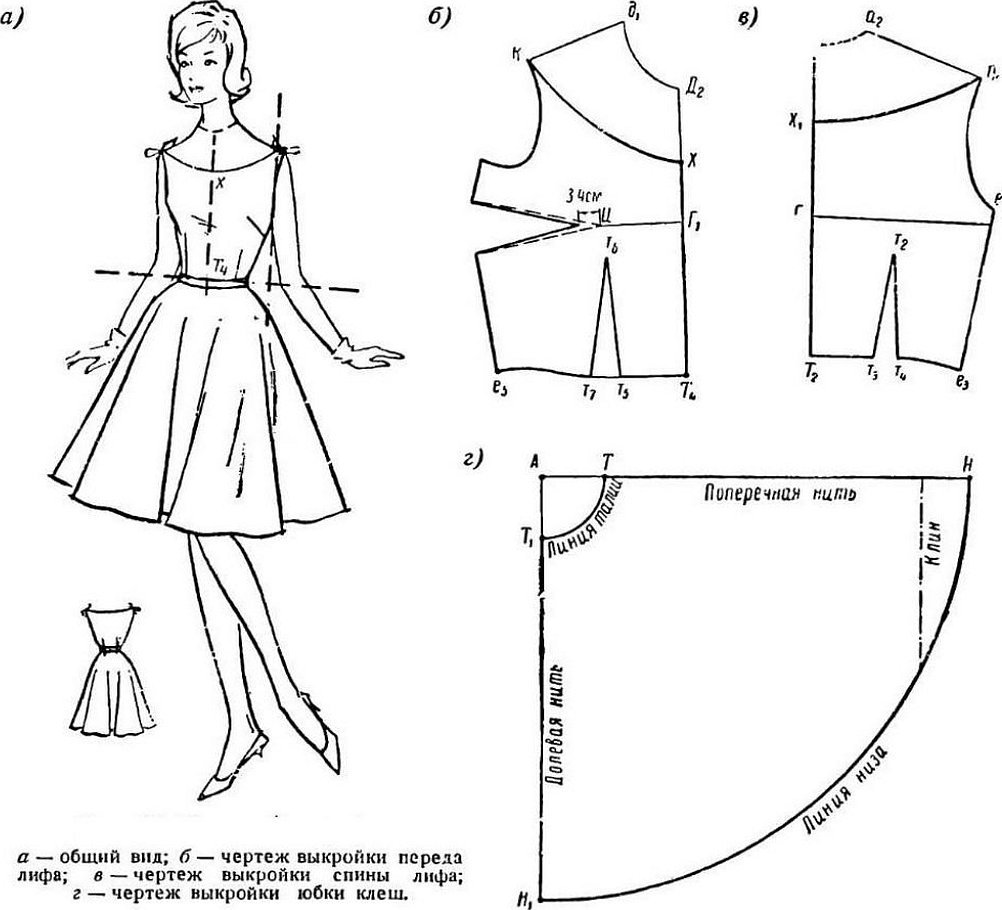
Features and techniques of sewing knitwear
When working with the sequence of making a pattern from knitwear, the features of the fabrics used for cutting and sewing are taken into account:
- Cut-out fabrics. Cut as if from fabric;
- Semi-regular canvases - processing is not carried out on all sides;
- Regular - the pieces are knitted in a circle, you just need to sew them together.
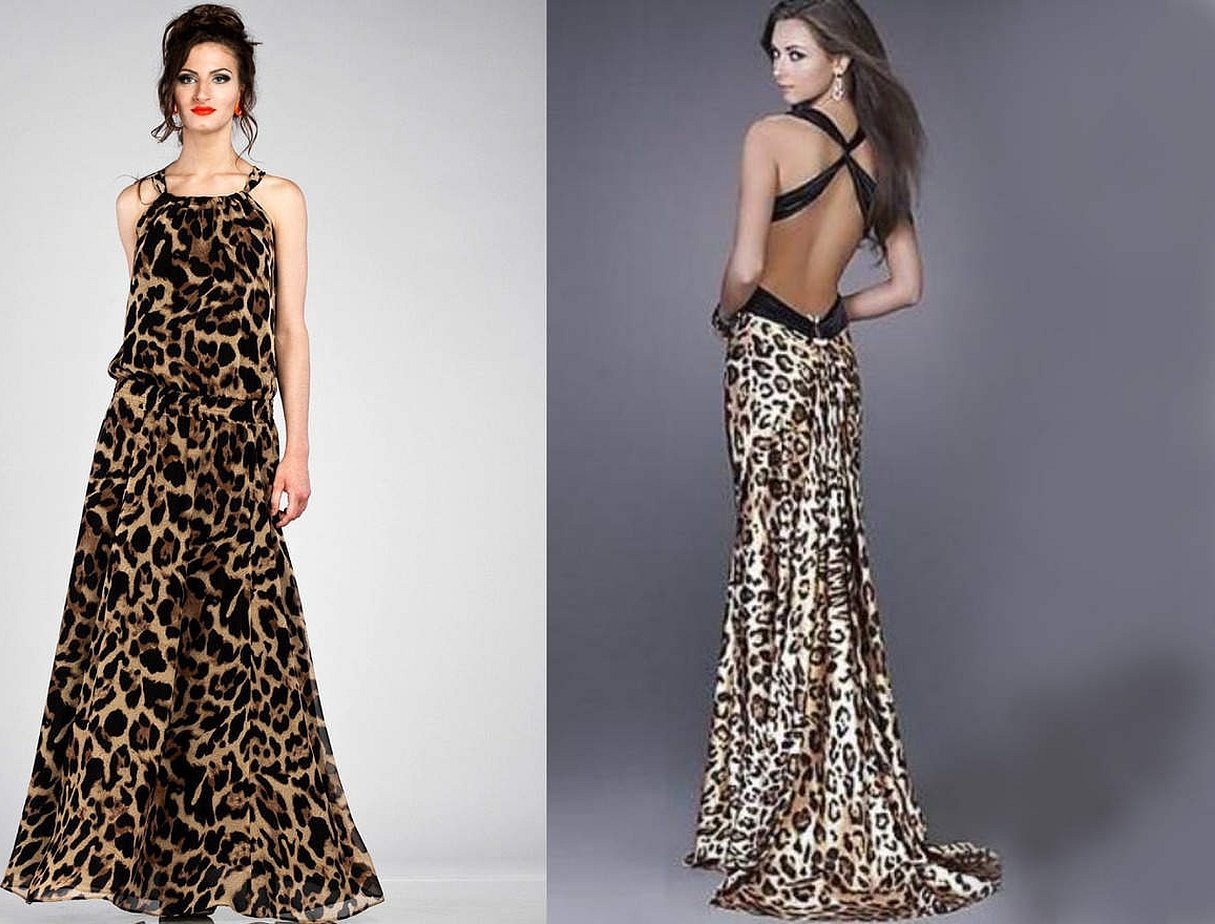
Sewing technique:
- The direction of the grain line is parallel to the straight edge of the product;
- The lower cuts of the lobes are directed in one direction when cutting;
- To avoid distortion, the material is not stretched crosswise;
- If it is difficult to mark the lines when cutting, you can carefully connect the fabric pieces with needles, keeping the same seam allowances;
- It is necessary to monitor the stretchability and strength of the seam. The seam should not pull or “gather” the material. The product should stretch together with the seam;
- For details, shallow cutting of the fabric in the allowance area is allowed;
- The armholes and neckline are edged with a diagonal strip of fabric;
- The overlock stitch is used when finishing the neckline;
- If you don't want the seam to stretch, you need to add bias tape when sewing it;
- The collar of the turtleneck is sewn on, slightly stretching the fabric;
- The bottom is folded manually with a free seam. The upper edge of the folded fabric is turned inward at a distance of half a centimeter;
- During work, the seams are ironed through gauze.
How to find out the degree of stretch of knitwear
- A sample of the fabric from which the knitted product will be sewn is taken.
- In the direction of the transverse thread, 2 marks are made at a distance of 10 cm from each other;
- The fabric is folded in half along the weft thread;
- The fabric is stretched and the distance between the marks is measured.
Important! The fabric must be stretched so that the pattern and structure of the material are not distorted.
Pattern of a dress with a stand-up collar
There are several types of stand-up collars:
- Shirt (turn-down with a cut-off stand). Used for sewing women's blouses, men's shirts. Comfortable to wear, softly fits the neck.
ImportantThe width and parameters of the stand depend on the collar configuration and are determined by the model and designer.
- Turn-down with a one-piece stand;
- Tuxedo collar;
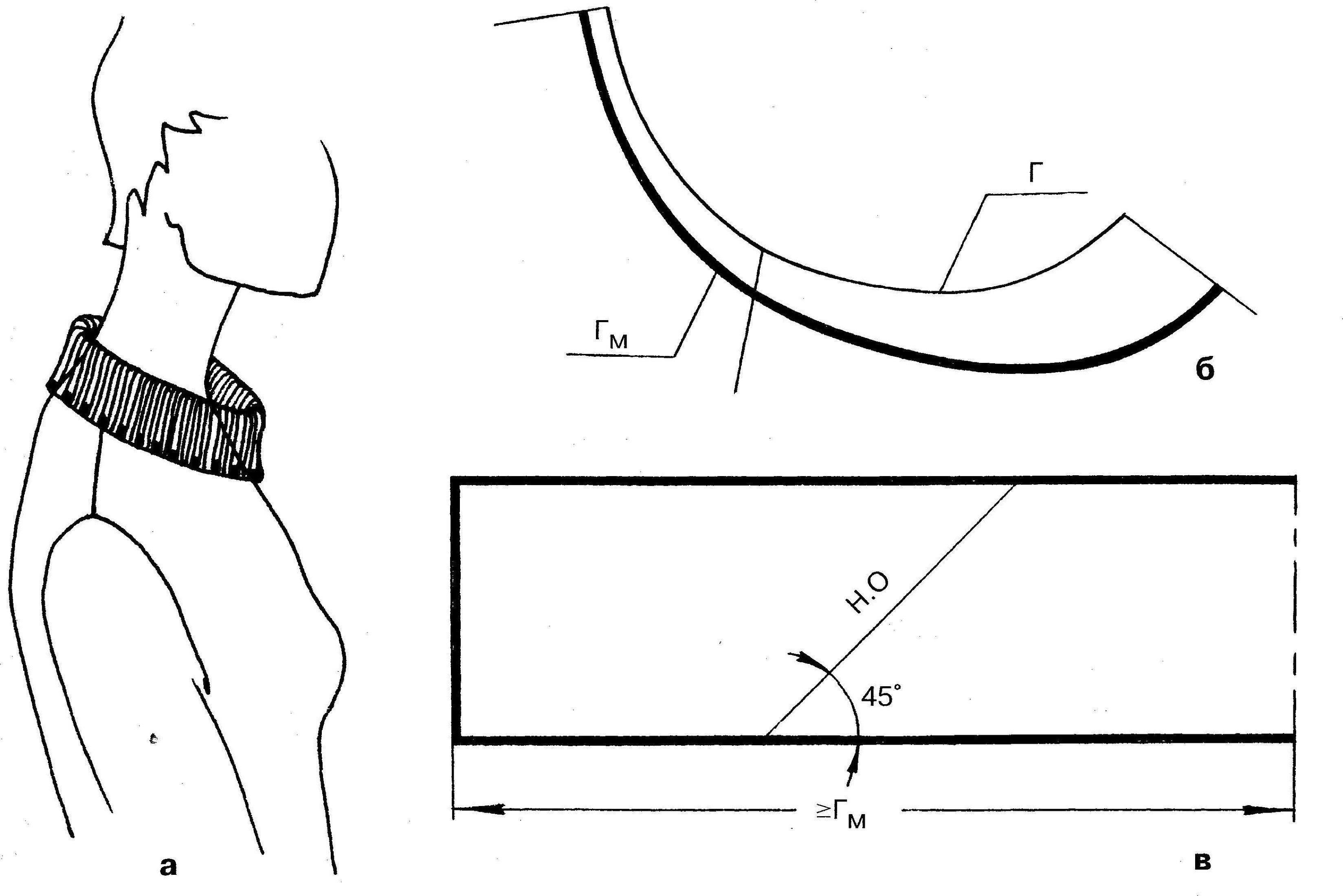
- Mandarin collar. The collar fits tightly to the neck without a fastener. In some products, a fastener is provided and is a loop of fabric that is thrown over a button with a shank.
To construct the pattern, the pattern of the front and back of the product is used.
The length of the neckline of the front and back is measured from the pattern (the distance between the control points for sewing in the collar).
Rectangle АBCD is constructed with the length of half the length of the neck on the pattern, the height is 6.5 cm. 4 cm are measured upwards from the point (the width of the collar varies depending on the selected model). 3 cm are measured upwards from point D. A curved line for sewing in the collar is drawn. The short side of the collar is drawn at a right angle to the segment, the upper side is drawn using a pattern or manually.
Several pieces are cut out along the fold line of the center of the back. Seam allowances are 1.5 cm. The outer part of the collar is duplicated with lining fabric.
Choose the style of a straight dress you like. Download the pattern and check the correctness of its construction with a measuring tape.
Please note! The pattern does not provide for allowances; the fabric is purchased taking into account allowances on the sides of 4 cm for hemming.
Dress pattern with draped waist
The product is based on a fitted dress pattern, which is slightly modified using ray lines.
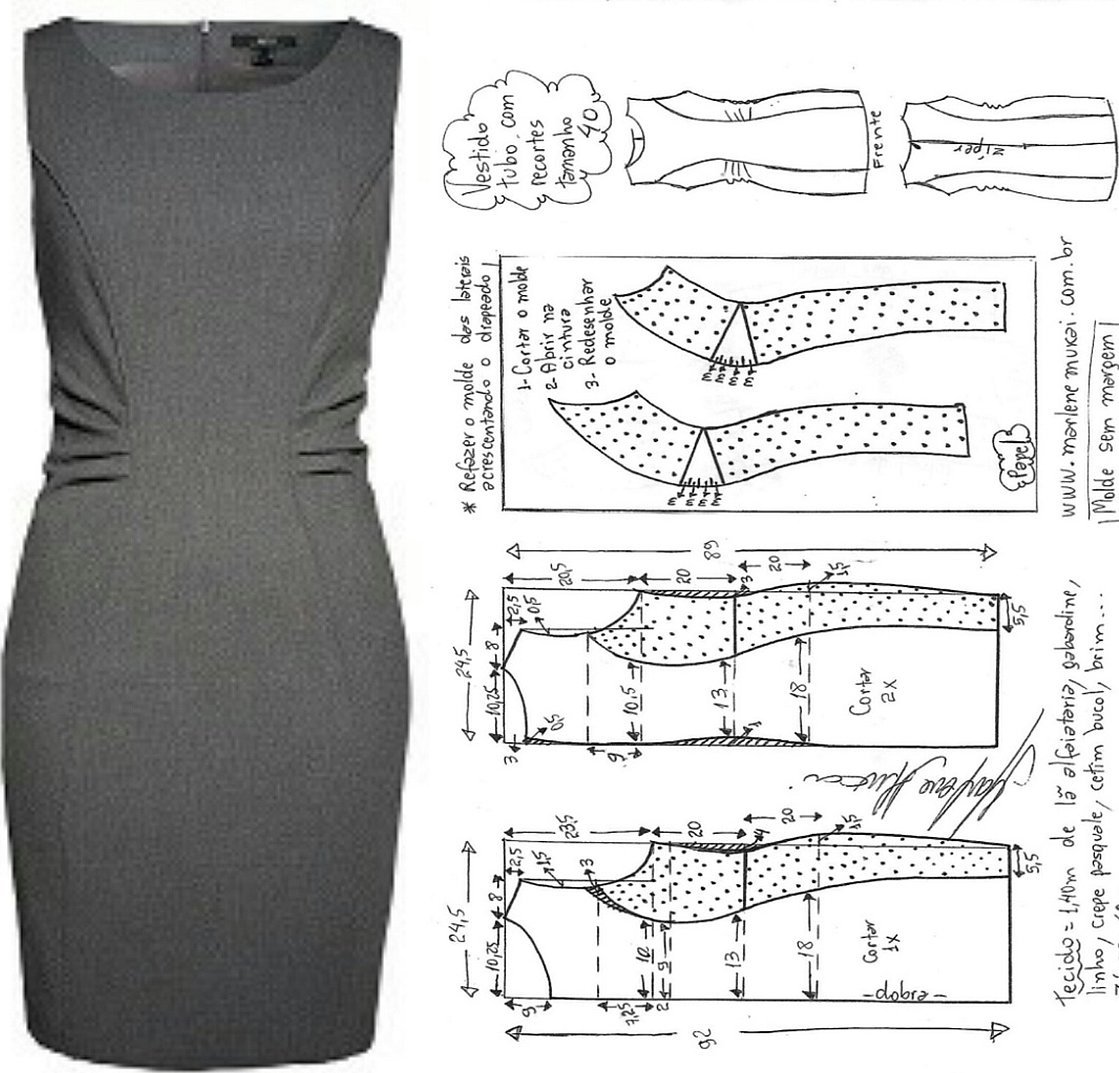
- Cut out the pattern, rays, leaving 0.5 cm from the edge. Move the workpiece apart.
- On the yoke, the darts are closed, it is connected to the right side, and the front of the dress is connected to the left.
- The pattern is transferred onto the fabric.
- The back of the product is cut along the fold.
- The seam that was marked in red on the pattern is sewn.
- The sewn piece is folded in half, and a stitch is started from the fold line of the fabric at a distance of 4 cm to form a hole into which the upper piece is threaded.
- The result is a gathering in the corner. Afterwards, knots are tied and at the very beginning of the overlock stitch, a fastening is made.
- The top part is threaded through the hole that was left.
- The fastenings are being made.
- The other 2 seams are sewn in the same way.
- The middle part of the back is sewn.
- The product is stitched from the sides and along the shoulder seams. The bottom of the dress is processed with a blind stitch, manually.
- The neckline and armholes are processed in the same way.
Please note! A dress with draping on the stomach is perfect for those who have ideal figure parameters. Draping on the bodice will highlight the advantages of the chest, hide wide hips.
Pattern of a sports dress made of knitwear with a hood.
You will need to cut out the following parts:
- A shelf is a detail with a fold;
- Back - 2 pcs.;
- Sleeve - 2 (if there is a seam - 4);
- Hood - 2;
- Hood facing -2;
- Sleeve cuff - 2;
- Bottom cuff - 1.
When working with a pattern, always follow the instructions.

Step-by-step algorithm
- Taking measurements: chest, arm, waist, hips. Arm length and product length.
Important! Before cutting, the fabric needs to be steamed. The material may shrink - this should be taken into account. When laying out the patterns, the direction of the grain line is taken into account.
- Selecting a pattern. Choose any product you like, download and print the pattern.
- Cutting. The parts are laid out on the canvas folded in 2 layers. Paired parts - in the singular, parts with a fold - along the fold line. If the canvas has 1 layer, you need to remember about cutting out paired parts.
- Basting. Knitwear is basted by hand. Seams on the material are not steamed - it is better to do a basting stitch by hand. After sewing the product, the basting must be removed. If the product is not basted, then the parts are pinned in the transverse direction of the seam, sewn on the machine.
- Stitching.
Important. You should monitor the tension of the thread - the thread should not be tight.
- The middle seam of the back is stitched. The allowances are ironed on both sides. The back is topstitched.
- The pocket is overlocked, a zigzag is made. The pocket is sewn to the shelf. All pocket allowances are pre-sewn, ironed from the inside;
- The middle seam of the sleeve is stitched (if the sleeve has 2 seams). The allowances are ironed. Stitching the sleeve. The allowances are ironed, the raglan is steamed. The bottom of the sleeve is processed with a zigzag.
- The cuff is overcast, ironed, pinned to the edge of the sleeve. The cuff is stitched to the edge. The cuff is folded over, the free edge is basted, stitched to the previous seam.
- If you decide not to make cuffs and sleeves, turn up the sleeve edges and stitch with a double stitch.
- Sew the shoulder seams. Iron back and steam.
- Stitching the side seams. Sewing in the sleeve. The armhole and sleeve cap are pre-pinned with needles and basted.
- Sew the hood darts. Iron to the center. Process the hood neckline with facing. Pin the hood edges to the neckline. Sew in the hood. Steam.
- Eyelets are installed.
- The hem is stitched with a double needle.
How to cut a knitted dress with sleeves using a pattern
There are a large number of patterns for knitted dresses on the Internet and in fashion magazines. To sew the perfect dress, you need to know how to cut out its parts correctly:
Side seam of the back and shelf
The position of the side seams is constantly changing. This is due to the type of clothing, silhouette, build of the person, the presence of other seams and details, the location of the darts relative to the waist, the cut of the sleeves and other factors.
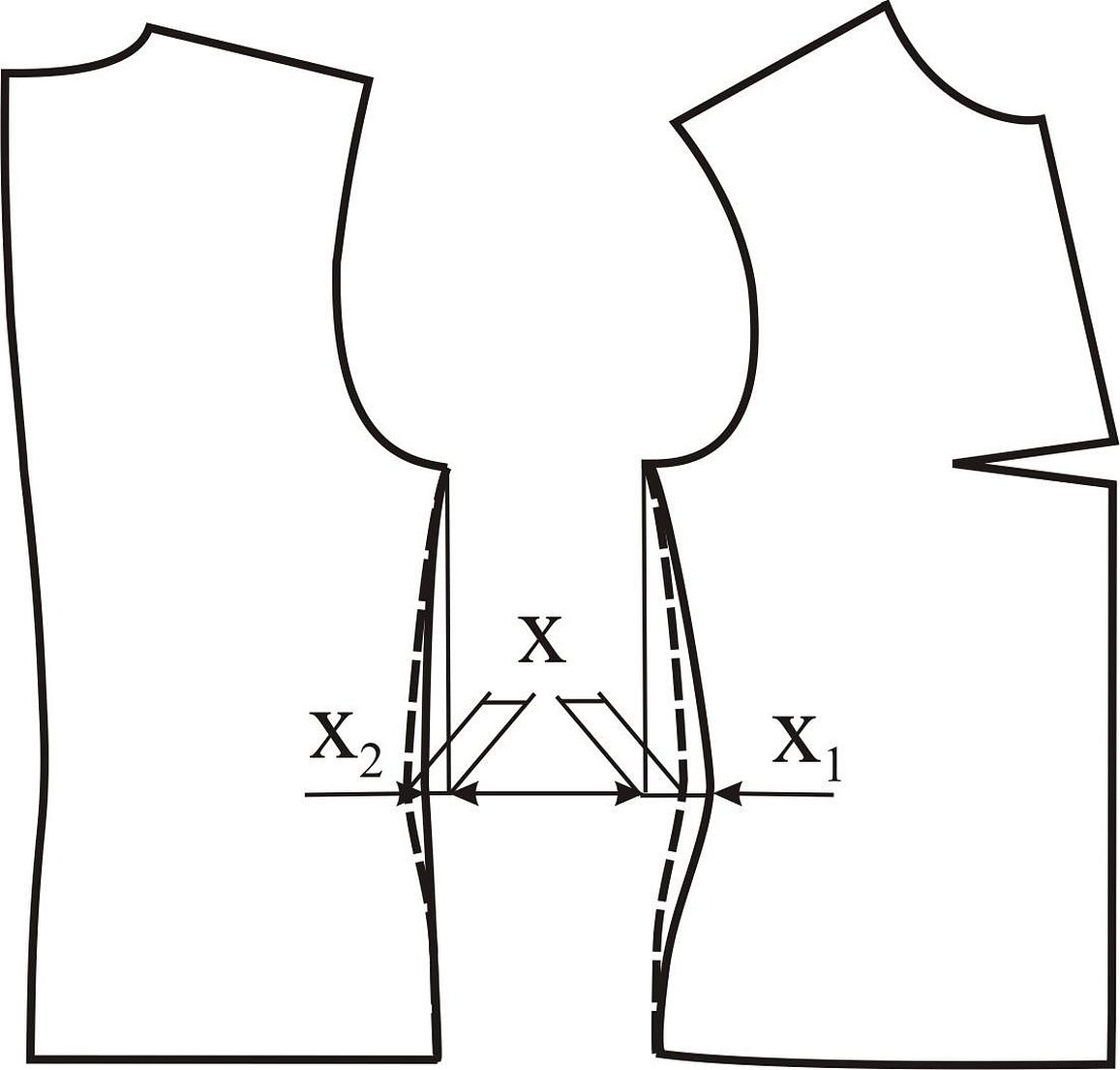
The construction comes down to determining the side lines of the dress armhole depth, waist, hips and bottom part and designing according to the pattern recommendations.
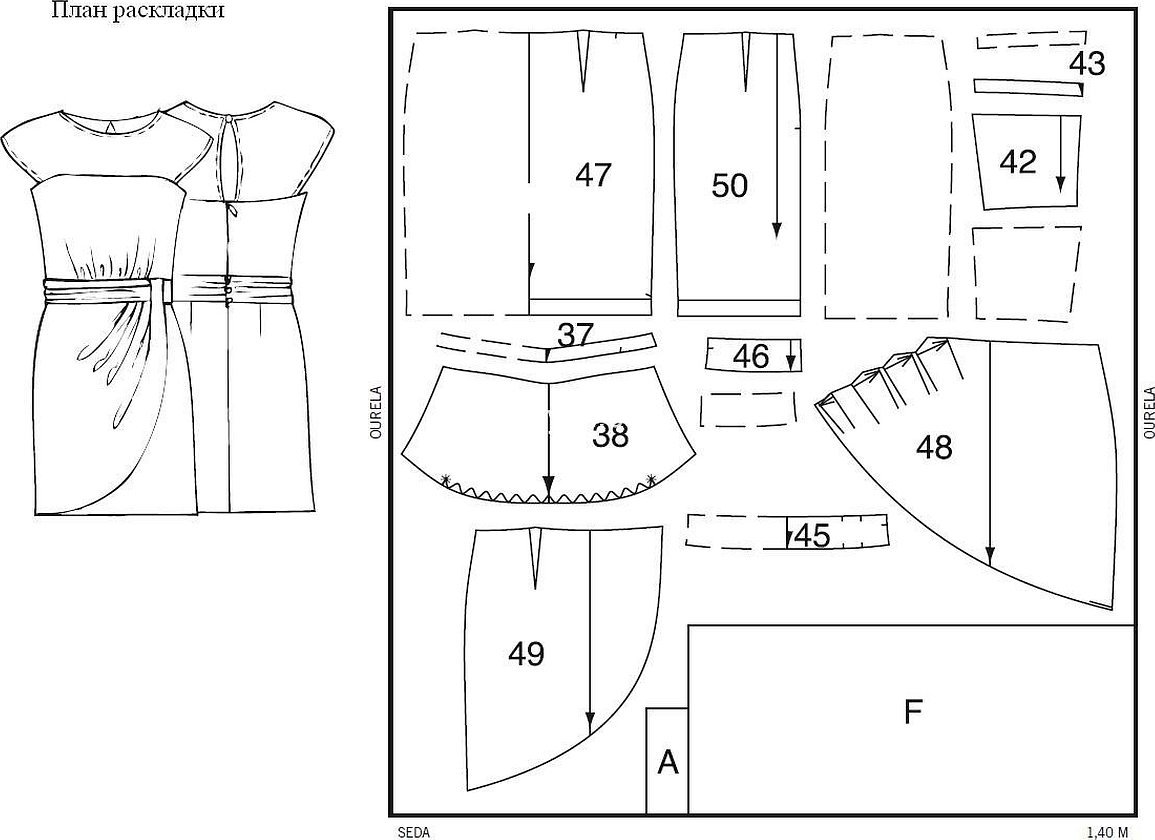
Side seams can be located:
- Straight cut near the shoulder blade and chest;
- Free cut and other cut items - closer to the middle of the armhole, aligning with it.
Find the position of the side seams using the formula: ∑B = (CrIII + Pg) - (St + Pt) - TT1.
For the side seam of the back and shelf, the value (2/5÷1/4)∑ is takenIN.
Important! The position of the side seam in fitted garments is found graphically, in which the allowance for ease of fit is 0.7 Pg. For this, the points of the side seam position on the bust line, hips are connected by straight lines, and later - concave. The degree of concavity is determined by the pattern.
Shoulder line of the shelf
When designing, the angle of the top cut is important:
- Large slope - the bodice has a strict, clear shape, the outline in the shoulder and armhole area is provided by the gusset; freedom of movement is ensured;
- Little slope or absence of the upper border of the sleeve - horizontal, the bodice has a large volume, soft shape, slack in the armhole.
Important. The sleeve width depends on the angle of the cut and the parameters of the armhole depth. A wide sleeve is obtained with a minimum angle of inclination.
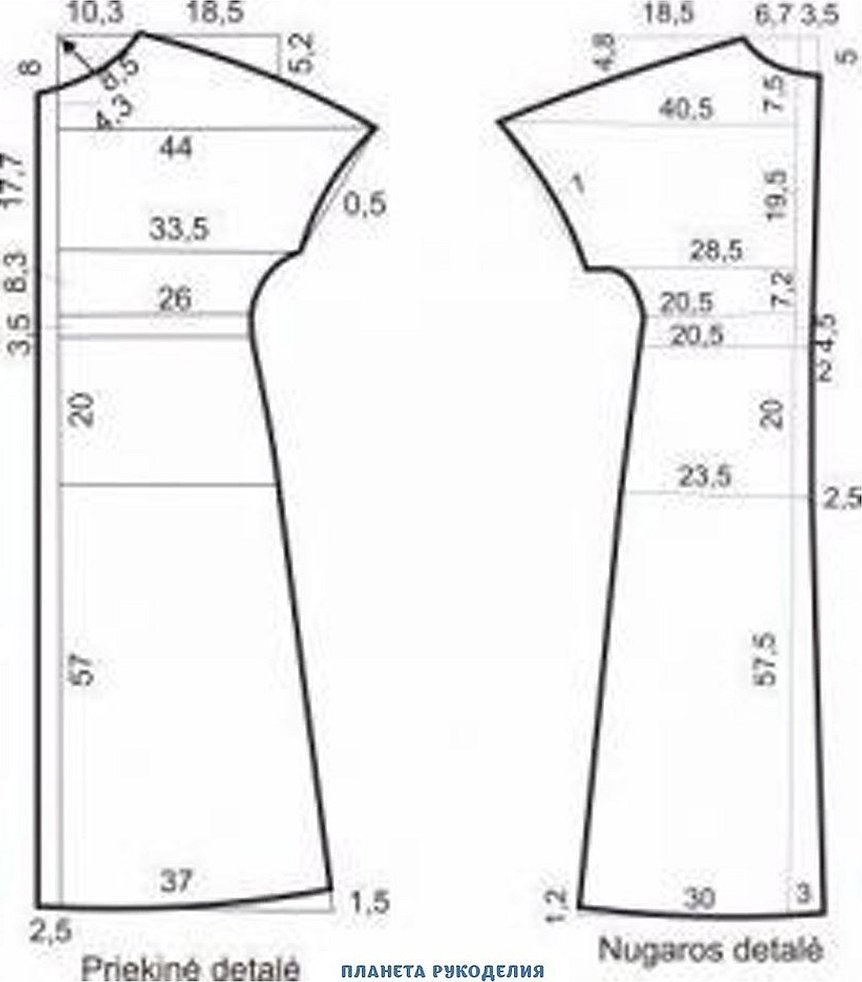
The base is a semi-fitted dress.
- The back and the front of the dress bodice are copied. The letters and lines involved in the construction are copied.
- Transfer the side line of the bodice to the middle of the armhole: draw a line from G4 to the intersection with the waist line.
Important! When constructing a soft bodice shape with long sleeves, the size of the side dart solution is reduced to 1.5 cm on each side.
The darts at the back and front waist can be of a minimum size and replaced with tucks and gathers, according to the pattern.
In straight, loose-fitting clothing, waist darts may be absent.
Additional freedom is given to the sleeve by moving the shoulder line and the back neckline.
Processing the bottom of the sleeve
Depending on the shape of the sleeve: with elastic, with a cuff, the processing is different.
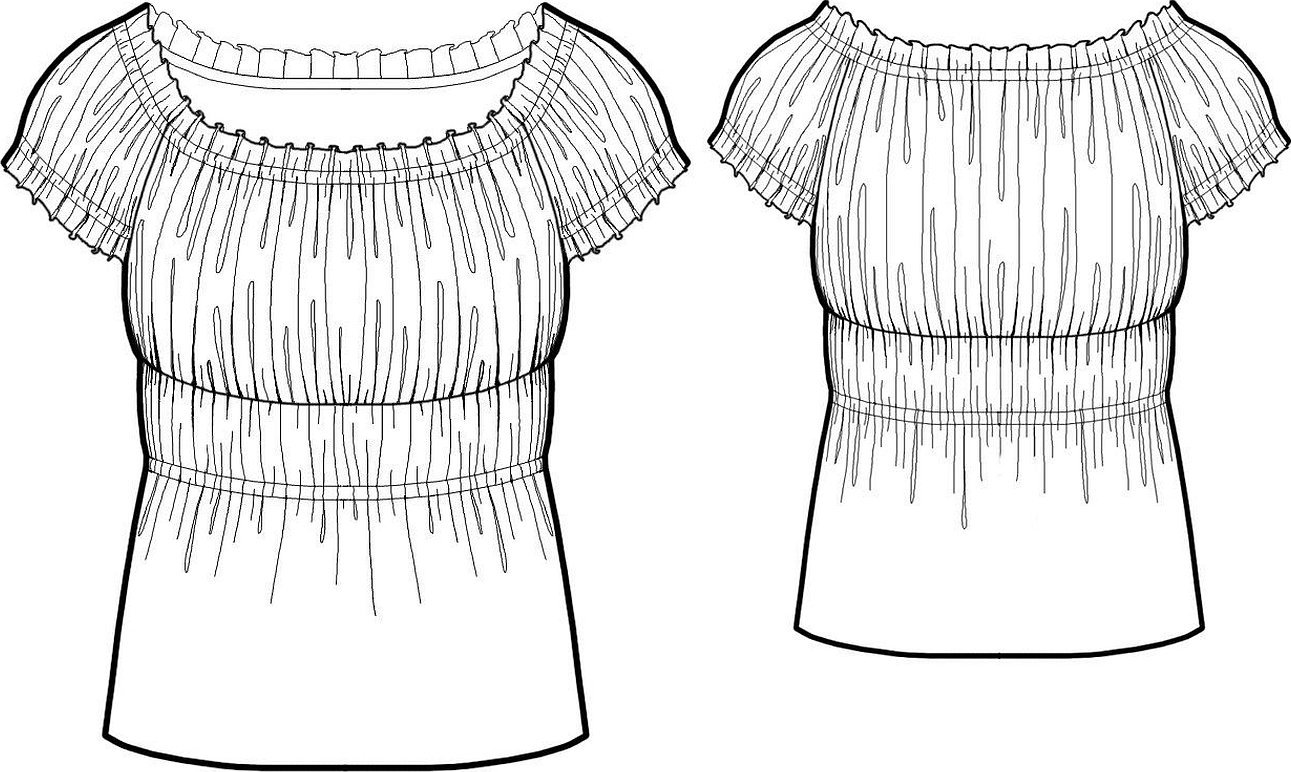
It is necessary to determine the required type of sleeve and make the appropriate processing.
How to sew a dress without a pattern
The absence of a dress pattern does not exempt you from taking basic measurements.
You don't have to make a pattern on paper, but rather cut clothes on fabric.
If you have decided to sew a dress, you must definitely sew, but try to make the sewing process as easy and accessible as possible. With the help of basic or ready-made patterns, as well as patterns that require minor changes, according to the style, this can be done much faster and better than starting everything from scratch.




